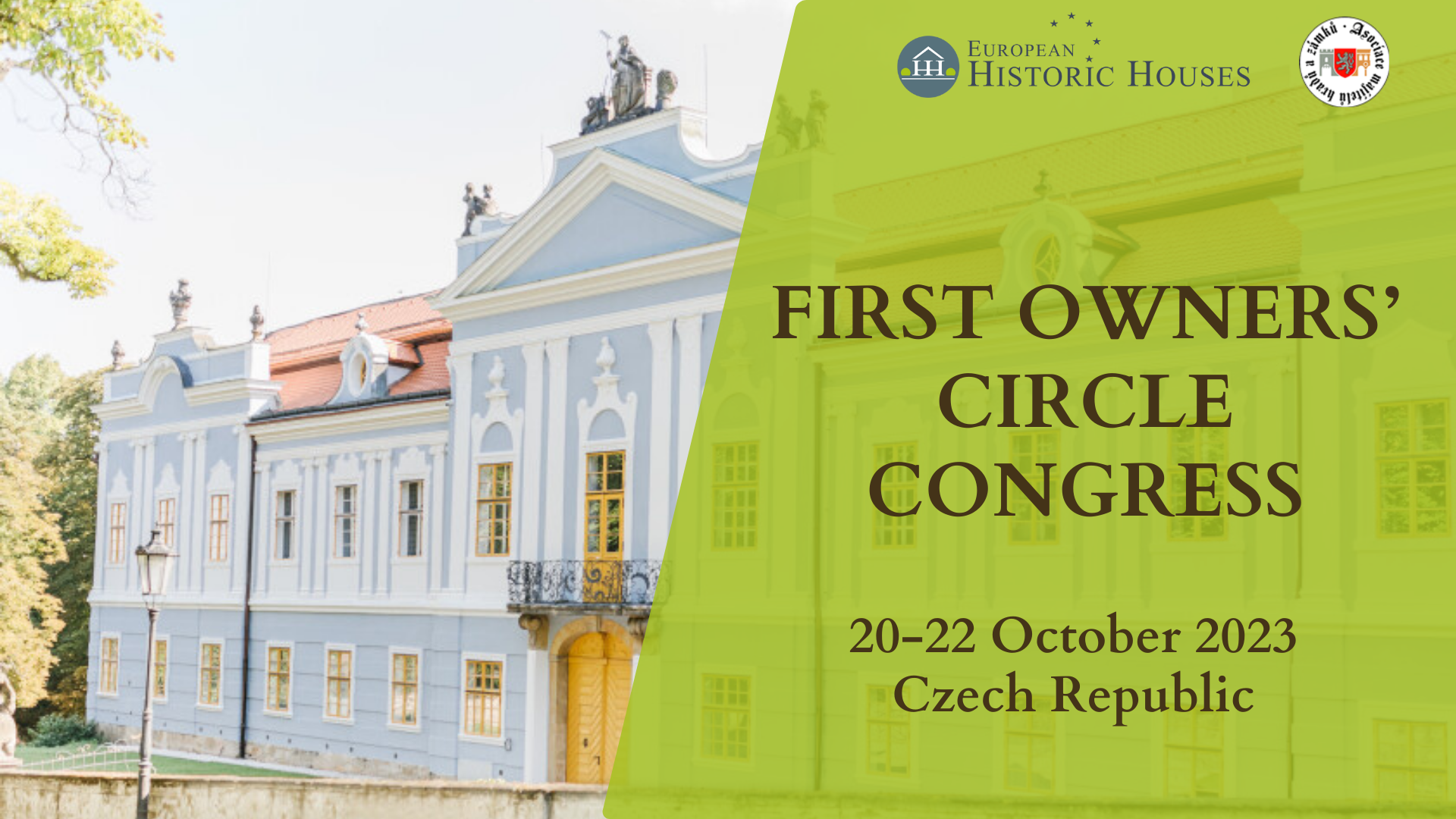
Please, check the full agenda of the event for more details here.
60 participants from 12 countries attended the inaugural European Historic Houses Owners’ Circle Congress, which took place on October 20, 2023, at Zamek Peruc in the Czech Republic. This event was made possible by the generous invitation of the Ondracek family and in collaboration with the Czech Manors & Castles Association (AMHZ).
Despite successful lobbying by European Historic Houses and its allied associations to ensure that exemptions would exist for historic properties within the new EPBD legislation, this year’s topic was focused on what we as Historic Houses owners can nevertheless do to contribute to the all-important imperative to reduce our carbon footprint, within the challenging constraints of listed building and landscape protections.
Architects Anders Brüel and Noah Boe-Whitehorn emphasized the importance of adopting historic maintenance solutions while embracing innovation. Practices like wall-hangings, appropriate ventilation, secondary glazing, and the use of historically accurate natural materials can significantly reduce the energy consumption of historic homes. Looking at the embedded carbon lifecycle analysis of renovation vs newbuild, Mr. Brüel presented data showing that conservation and renovation can outperform new construction, especially when considering the eventual shift to sustainable energy sources in the coming decades. Mr. Boe-Whitehorn was also keen to impress the importance of considering the longevity and reparability of work undertaken in restoration or new construction projects, of re-use where possible, and of using products offering sustainable disposal at end of life.
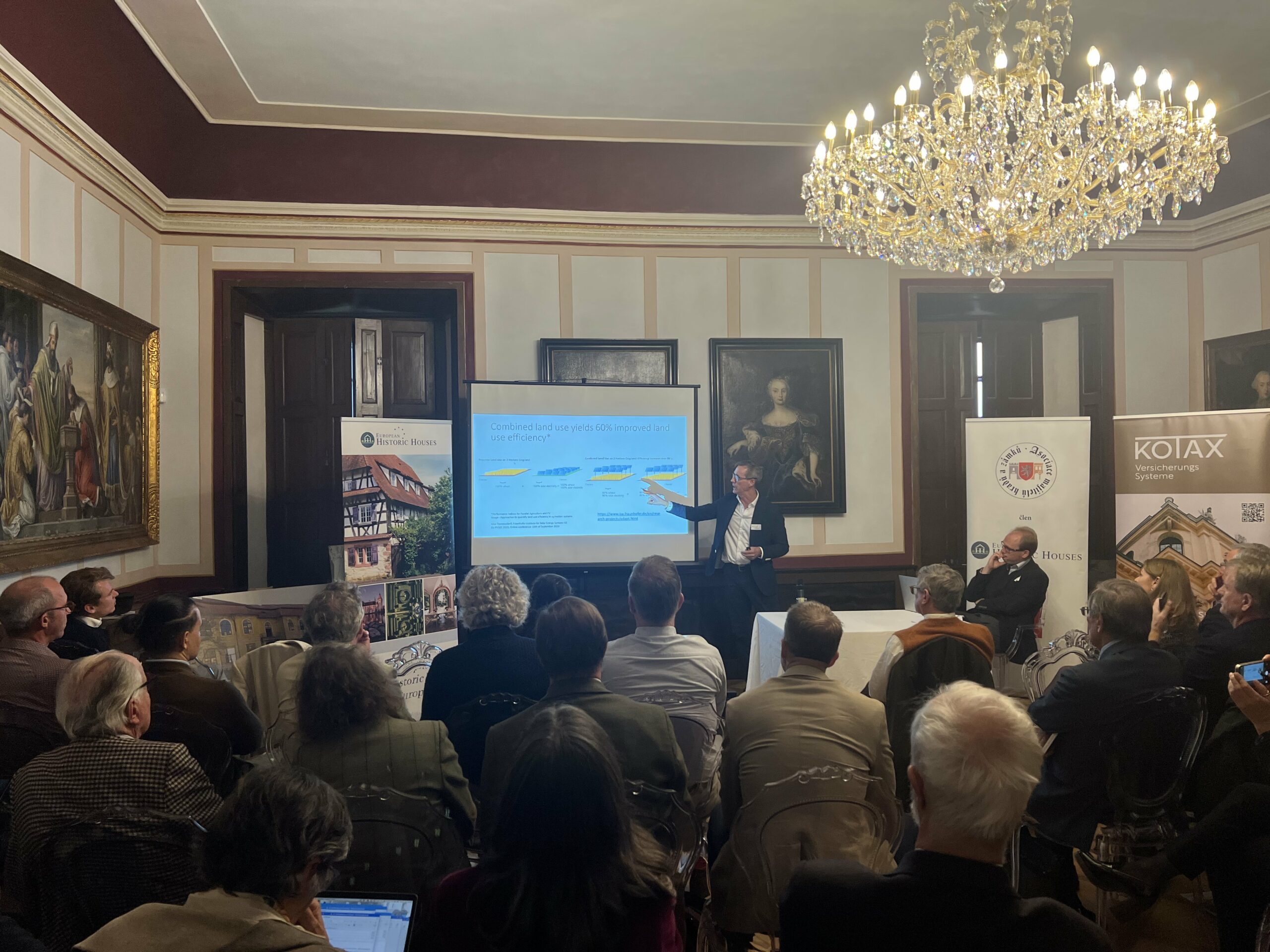
Energy generation was a prominent theme, and John Reisky de Dubnic delivered an inspiring speech about his family’s renovation project at Vilémov Castle. Having received the property through restitution in a parlous state, he and his wife’s passion for the place was clear to see. With climate change threatening their forestry business, their plan to pivot the castle towards district heating for the town’s 1500 residents through agrisolar, plus a conversion into the hospitality sector.
Sister Monika Edinger, as Mother Superior for the monastery of Würzburg, had travelled with her architect Sandra Räder to explain how they had taken a huge leap forward in becoming the first historic monument in Bavaria (Germany) to install solar voltaic tiles on a heritage property. There was much interest in the sample tile which was passed around the room, and this same sample will make its way now to the office of the Czech Deputy Minister for Culture Vratislav Ouroda, who was kind enough to be present for part of the conference and the evening dinner.
Alexander Kottulinsky, representing Kotax Insurance (one of this year’s sponsors), shared his experience with a ground-mounted solar project that had already produced 8.7GWh in its first year, thereby supporting the castle’s maintenance and green agenda. He also revealed plans for his next move into renewables: a geothermal plant which would heat 20ha of greenhouses for agricultural and horticultural production, whilst also offering excess heat to the village.
Heat from a different water source was explained by Stijn de Jonge, whose company Extraqt specialises in water-based heat pumps. With 50% of energy use estimated to go towards heating in northern European countries, and with many historic houses sitting near to rivers or surrounded by moats, this is a good place to start when considering renewables.
Finally, Hendrik Van Eeckhout from Spantech (who also generously sponsored the event) highlighted the importance of considering temporary, reusable, long-life structures for situations where additional space may be required near historic properties, such as for wedding reception venues, temporary concert spaces, or restaurants. These structures can offer a simpler, quicker, and cheaper solution while presenting fewer challenges to planning and heritage officials.
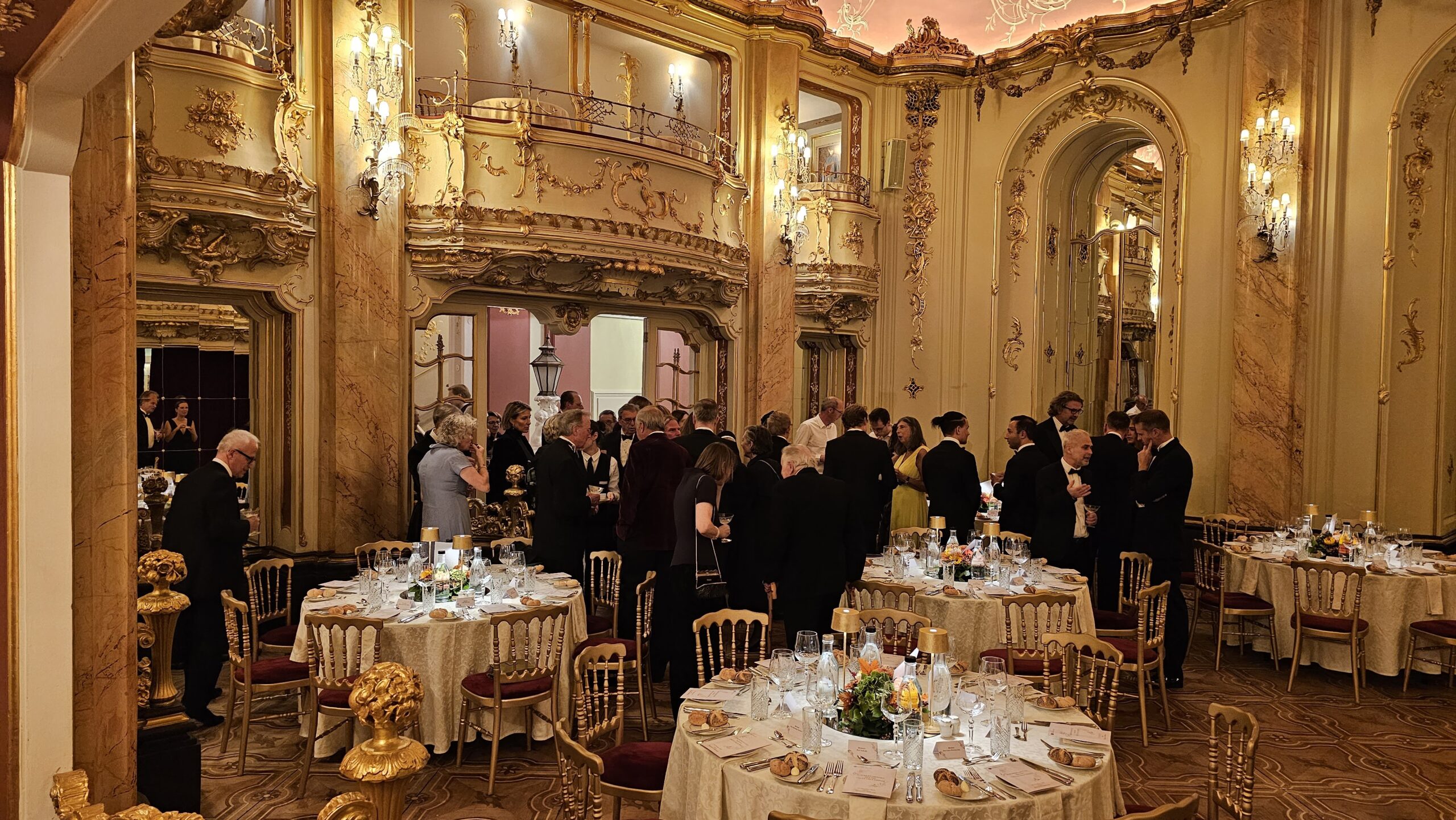
This diverse and inspiring conference was followed by property tours before participants returned to Prague for the Gala Dinner held at the Boccaccio Hall, a stunning ballroom and last surviving original part of the Grand Bohemian Hotel. Constructed in 1908 in the Rokoko style, the ballroom provided the perfect backdrop for the launch of the Airbnb European Sustainable Heritage Award. Barry McKeon, Senior Public Policy Manager at Airbnb, gave an enthusiastic speech explaining why heritage was important to the company, not only as providing many interesting places to stay, but also as important attractors to regional tourism, which in turn supports their over 1.3 million hosts to fill their properties. Sustainability is also a key driver in travellers’ thinking today, and so to be able to offer €40,000 of prize money to deserving environmental projects in historic properties made good sense for all concerned.
Ewelina Oksiuta, Head of Office at European Historic Houses, was keen to stress the simple and accessible application process for the award, encouraging projects of all sizes to come forward. More details about the award can be found in the following link:
Officially launching the Owners’ Circle, William Cartwright-Hignett welcomed the participants, thanked the national association for their support, the Vice Minister for his interest, and asked those present to imagine what the group might become with only a little effort. He encouraged anyone interested to come forward and support the group’s development by joining the Circle Committee who would help to ensure the beneficial direction of the group’s focus.
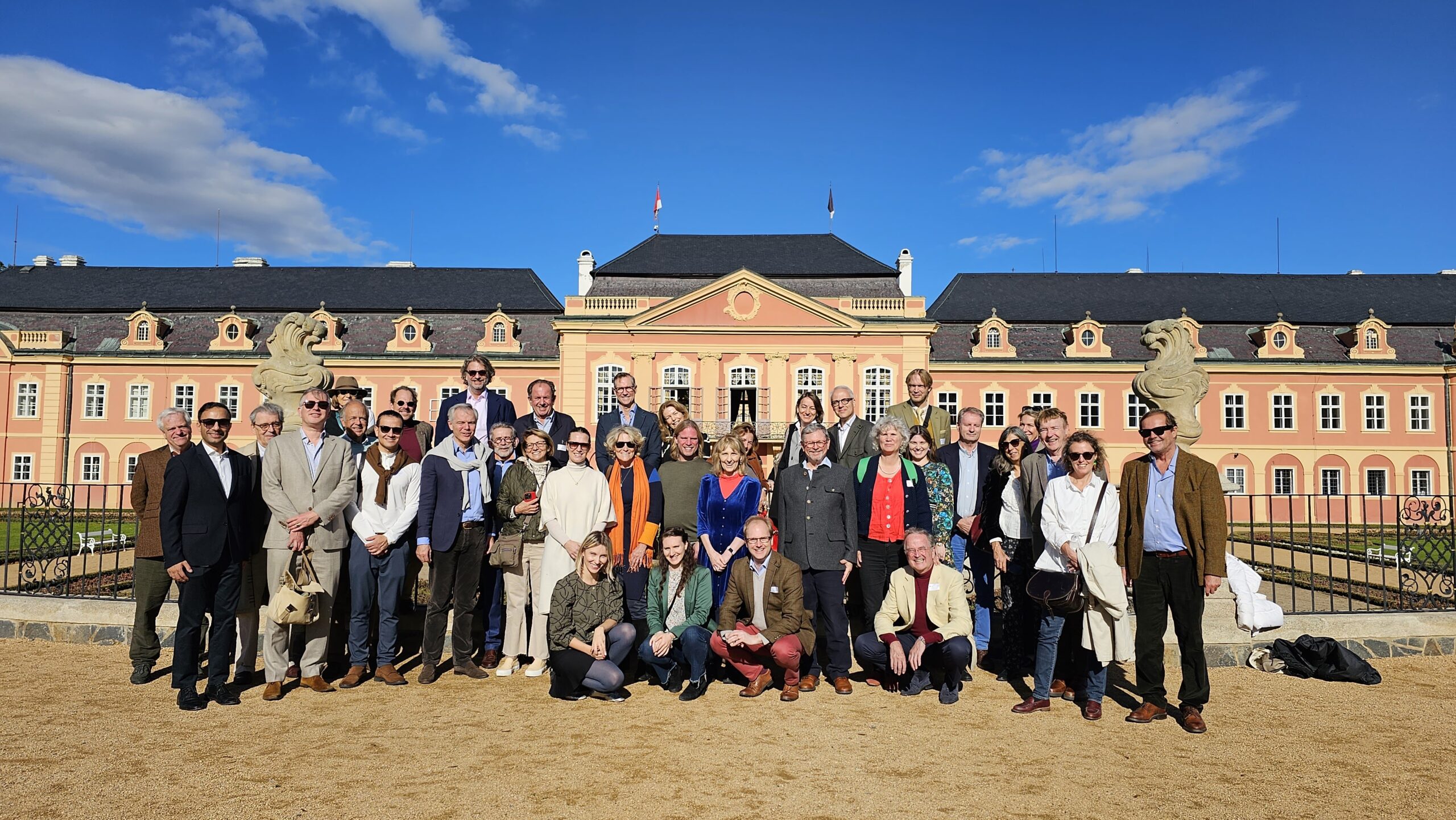
Saturday 21 and Sunday 22 saw a programme of visits, kicking off with a visit to Castle Dobříš. Undeniably an exceptional and ongoing restoration project but facing the challenge of having not received back the original furniture, the team has been working with other furniture companies to restore the rooms to their former glory. Now housing a 10-room hotel, working as a wedding venue, and in the throes of renovating their restaurant, the guides showed us also how their education suite is a way to connect with the community and wider visitors. Dobříš was the recipient of ERDP funding to renovate the enormous trompe l’œil folly above Platzer’s now restored statue of Helios at the top of the garden overlooking the house.
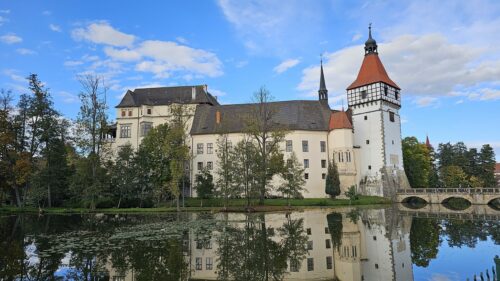
Second stop on the tour was the no less impressive Castle Blatná, home to Jana Germenis-Hildprandt and her son Stephanos. The connection that this water castle has to its community was evident immediately and one could feel how valued the building was by the local residents who were walking their prams over the drawbridge, feeding the deer in the exquisite parkland, and using the courtyard café. We were privileged to be able to see behind the scenes on our tour, to see the next phases of interior restoration which would enable some rooms to be let out as a hotel. Stephanos’ grandfather was an important hunter and trophy antlers were not in short supply inside, having been converted into everything from chandeliers to dining chairs!
The day ended at Castle Hradek with a dinner, and a tour the following morning on Sunday by the owner, Mr Lejsek. Unlike Blatná, Hradek was purchased by the present owner who is himself an architect and over 25 years the property has been beautifully put back together and converted into a hotel, with modern wellness facilities constructed next door. It represents a great example of the rebirth of a historic building from its ruined state into a commercially sustainable future all through the passion of its owner.
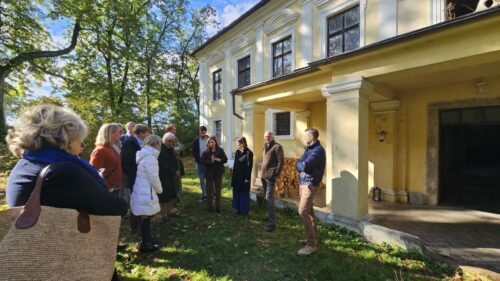
Sunday’s tour ended with a visit to Daria Krstev at her wildly romantic property Castle Otín. Having seen already a number of nearly-completed restorations, it was fascinating to see a project right in the middle of its undertaking and at a much earlier stage of development. Everyone was in total agreement that Daria’s passion for the place was beyond admirable, and we were grateful that we could all share in her excitement for the next steps of her property.
For many of the participants approaching this weekend from West of the former Iron Curtain, it will have been an eye-opening experience: the density of beautiful historic properties in the countryside, every village on the road seemingly housing hidden gems; the utterly devastating history within living memory for most; the incredible passion and reconstructive efforts of the restituted or new owners; and the thought that this work had mostly only taken place in the last 30 years.
The Czech Republic’s historic houses truly are on a journey, and if ever there were proof that it is only truly through the efforts of private individuals – always passionate about preserving their properties and the social legacy that those properties offer to their community – that historic houses will continue to flourish long into the future.
